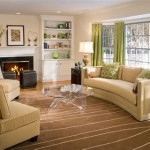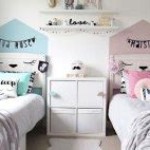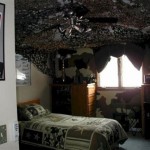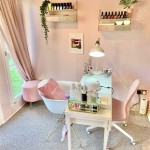How To Decorate a Bedroom Shared With a Baby
Sharing a bedroom with a baby is a common situation for many families, particularly when space is limited or during the initial months after birth. Integrating a baby's necessities into an existing bedroom while maintaining a functional and aesthetically pleasing space requires careful planning and execution. Functionality, safety, and personal comfort must be balanced to create an environment that works for both the adult(s) and the infant. This article outlines key considerations and practical strategies for successfully decorating a bedroom shared with a baby.
Prioritize Safety First
Safety is paramount when decorating a shared bedroom. The environment must be free from hazards that could potentially harm the baby. This necessitates careful assessment of the room’s existing features and the implementation of preventive measures. Sharp corners on furniture should be protected with corner guards. Heavy furniture, such as dressers and bookcases, should be securely anchored to the wall to prevent tipping. Electrical outlets should be covered with safety plugs. Cords from lamps, baby monitors, and other devices should be kept out of the baby’s reach. Furthermore, the crib itself should meet current safety standards, including proper slat spacing and a firm mattress. Avoid placing the crib near windows with dangling cords from blinds or curtains, and keep potential choking hazards, such as small toys or decorative items, out of the baby's reach at all times.
Maximize Space with Strategic Furniture Placement and Storage
Efficient use of space is crucial in a shared bedroom. Employing smart furniture choices and storage solutions can help maximize the available area and keep the room organized. Consider using multi-functional furniture, such as a crib with built-in storage drawers or a changing table that can also function as a dresser. Opt for wall-mounted shelves and organizers to utilize vertical space and keep items off the floor. Under-bed storage containers are another excellent way to store less frequently used items. When arranging furniture, create clear pathways to ensure easy movement within the room. Position the crib in a location that minimizes disruption to the baby’s sleep, away from direct sunlight, drafts, and noisy areas. Streamline the number of toys and baby care items by implementing a regular decluttering routine. Ensure that the baby's necessities are readily accessible, but out of the child's reach when they are sleeping or unsupervised.
Establish Separate Zones and Boundaries
Creating visual or practical boundaries can help define the separate spaces for both the adult(s) and the baby. This helps delineate the baby’s area for sleeping, playing, and changing while clearly identifying the parent’s personal space. A simple way to achieve this is by using a room divider, a screen, or even a strategically placed bookshelf. Color can also be used effectively to define zones. Consider painting an accent wall in the baby's area, or incorporating a rug to visually separate their space. Ensure adequate lighting in both zones, with options for dimming for the baby's area. Furthermore, try to establish distinct routines for each space. For example, keep the adult’s workspace or relaxation area separate from the baby's play area so that the space can remain calm when the baby is sleeping. This separation will help promote a better flow of activities and enhance both adults’ and infants’ ability to rest harmoniously in the shared space.
Consider the Color Palette and Lighting
The color scheme and lighting can significantly impact the mood and functionality of a shared bedroom. Choose a color palette that promotes a calming and soothing environment for the baby, while also reflecting the adults' personal tastes. Soft, muted colors like pastels, neutrals, and earth tones are often preferred for nurseries. Avoid overly stimulating colors or patterns, particularly in the baby’s sleeping area. However, this does not imply you cannot include some bold colors, especially in accessories, to create the room’s aesthetic. Consider the lighting needs of both the baby and the adult(s). Layering different light sources, such as a ceiling light, a bedside lamp, and a nightlight, allows for adjustable illumination for various activities. Choose energy-efficient LED bulbs that provide adequate brightness without generating excessive heat. A dimmer switch can be installed to control the light intensity, allowing for gentle lighting for nighttime feedings and diaper changes. Additionally, ensure proper ventilation and air quality to promote a healthy environment for both the baby and the adults sharing the room.
Implement Effective Sound Management
Managing noise levels is essential for creating a peaceful environment, especially when sharing a bedroom with a baby. Babies are easily awakened by sounds, and even the slightest noise can disrupt their sleep. Strategies for sound management can include using a white noise machine or a fan which generates soothing ambient sounds that can also mask other noises. Additionally, install thick curtains or blackout blinds to minimize external noise from traffic or from other sources. Consider using soft materials, such as rugs and carpets, which can help absorb sound and reduce echo. If possible, avoid placing the crib near the wall that adjoins a noisy area of the house. Communicate with other household members regarding noise levels, enforcing a “quiet time” policy, especially during nap times and at night. These measures will help minimize noise and promote a more restful environment for both the baby and the adults.
Incorporate Practicality and Aesthetics
Striking a balance between practicality and aesthetics is key to designing a shared bedroom that is both functional and visually appealing. While safety and functionality are paramount, it is still possible to incorporate personal style and design elements to create a space that feels comfortable and welcoming. Choose furniture and accessories that complement the existing décor of the bedroom. Add decorative items, such as artwork, photographs, or plants, to personalize the space. Organize and store baby supplies in attractive containers or baskets to minimize clutter while still keeping everything easily accessible. Furthermore, consider including a comfortable seating area for feeding and cuddling the baby. When selecting textiles, choose soft, washable materials that are easy to clean. Regular cleaning is also of the essence, and consider a routine for cleaning the space that is effective and prevents the build-up of dust and allergens.

Pin On Home Decor Ideas

Sharing A Room With Baby 8 Space Saving Ideas Today S Pa

Pin On House Decorating Ideas

Best Nursery Nook Ideas Creating Space For Baby In A Master Bedroom

17 Helpful Design Tips When Sharing A Room With Baby Nursery Studio

Shared Baby Room

Sharing A Room With Baby 8 Space Saving Ideas Today S Pa

Pin On Home

Room For Two 19 Beautiful Baby And Toddler Shared Bedrooms

33 Delightful Shared Nurseries For A Baby And Toddler Digsdigs
Related Posts







